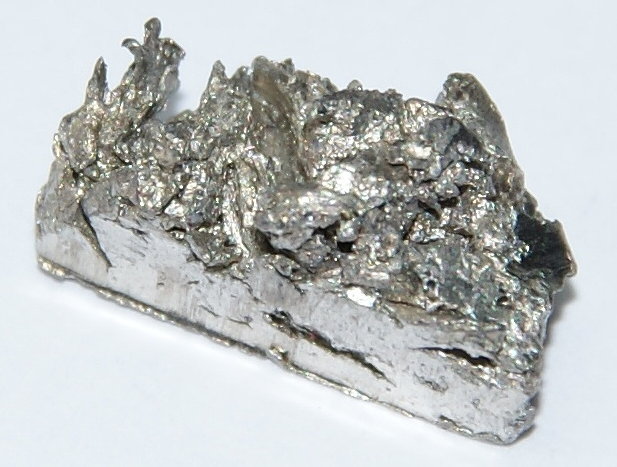
Ytterbium (Yb) is a rare earth element with atomic number 70. It was initially discovered in 1878 by Swiss chemist Jean de Marignac. It was named after the Swedish village of Ytterby and is a soft, white, silvery metal that may be readily bent and cut. It belongs to the lanthanide series of the periodic table.

Jurii, CC BY 1.0 <https://creativecommons.org/licenses/by/1.0>, via Wikimedia Commons
Ytterbium metal has several unique properties:
Soft and Malleable: It is soft and can be readily bent and shaped.
Bright Appearance: Ytterbium has a shiny surface but slowly turns golden or brown when exposed to air.
Reactive: It reacts slowly with cold water but faster with hot water. It also reacts with acids and halogens.
Magnetic Behavior: Ytterbium is paramagnetic at temperatures above 1 Kelvin, unlike many other rare-earth elements.
Three Forms: Ytterbium has three different crystal forms, which change with temperature.
Ytterbium is found in some rare minerals such as monazite, euxenite, and xenotime. The predominant mining areas for ytterbium are China, the United States, Brazil, India, Sri Lanka, and Australia. Ytterbium is extracted from monazite sand that contains about 0.03% ytterbium. The planet produces about 50 tonnes of ytterbium per year.

Rob Lavinsky, iRocks.com – CC-BY-SA-3.0, CC BY-SA 3.0 <https://creativecommons.org/licenses/by-sa/3.0>, via Wikimedia Commons
In order to obtain ytterbium, its ores are put through a process that separates it from other elements. The process is carried out based on methods such as solvent extraction and ion exchange.
Naturally occurring ytterbium consists of 7 stable isotopes: Yb-168, Yb-170, Yb-171, Yb-172, Yb-173, Yb-174, and Yb-176. Among these, Yb-174 is the most abundant. Each of the isotopes plays a different role in contributing to nuclear, magnetic, and quantum study applications.
Ytterbium is a versatile element with many practical uses in various industries:
Improving Stainless Steel: Stainless steel is reinforced with ytterbium to harden and harden the metal. Ytterbium improves the grain structure of the metal, which makes it stronger and more wear-resistant. This renders the steel adaptable for usage in austere conditions, like construction and heavy equipment.
Dental Alloys: Alloys that contain ytterbium are used in dental fillings and crowns. These alloys are strong and resistant to corrosion, which makes them suitable for use in the mouth. They help restore damaged teeth and improve the durability of dental work. Dentists use these alloys because they last longer and do not react with saliva or food.
Portable X-Ray Machines: Ytterbium-169, being a radioactive source of an isotope, is used as a gamma-ray source in handheld X-ray machines. Handheld X-ray machines are convenient when there is no electricity available, e.g., in the wilderness or during an emergency. Ytterbium-169 gamma rays can pass through soft tissue and help take good bone and internal organ images.
Atomic Clocks: The most precise atomic clocks utilize Ytterbium. The ytterbium atoms' stable vibrations are utilized to maintain time in such clocks with precision. Ytterbium-based atomic clocks are so precise that they are just one second short after a few million years. It is used in global positioning systems (GPS), telecommunication, and scientific experiments.
Industrial Catalyst: Ytterbium compounds are also used as a catalyst for chemical reactions. They help speed up processes that would otherwise take longer or more energy to do. An example of this is ytterbium catalysts being used in plastics manufacturing, pharmaceuticals, and other chemicals. They are used because they are effective and reduce the usage of more toxic or expensive materials.
Fiber Optic Communications: Ytterbium is a significant dopant for high-power fiber optic amplifiers. It enhances signal strength in long-haul data transmission and minimizes energy loss and heat degradation. This makes it a critical material for next-generation telecommunications and broadband systems.
Quantum Computing: Ytterbium ions, and more particularly the 171 Yb+ isotope, are used in quantum computers. Quantum computers employ quantum bits, or qubits, to perform complicated computations far more quickly than regular computers. Ytterbium ions resist thermal fluctuations and are easy to handle, which makes them ideal for use in the development of quantum technology. This technology will revolutionize fields like cryptography, data analysis, and artificial intelligence.
Ytterbium may pose particular health risks:
Irritant: It can irritate the skin and eyes.
Toxicity: Ytterbium and its compounds are highly toxic, and precautions should be taken to avoid exposure.
Storage Needs: Ytterbium should be stored in airtight containers, away from air and moisture, as its dust can catch fire easily.
Despite these risks, ytterbium is harmless to plants and animals as well as environmentally safe. Ytterbium salts are being utilized as safer alternatives to more toxic chemicals in industry.
Ytterbium is a rare-earth metal with many positive applications. Utilized to strengthen stainless steel for medical diagnostics, its uses are vast. Special care should be taken while handling it since it is toxic, but its use in technology and industry makes it a valuable element. To learn more about ytterbium and other rare earth elements, visit Stanford Materials Corporation (SMC).
Eric Loewen
Eric Loewen graduated from the University of Illinois studying applied chemistry. His educational background gives him a broad base from which to approach many topics. He has been working with topics about advanced materials for over 5 years at Stanford Materials Corporation (SMC). His main purpose in writing these articles is to provide a free, yet quality resource for readers. He welcomes feedback on typos, errors, or differences in opinion that readers come across.